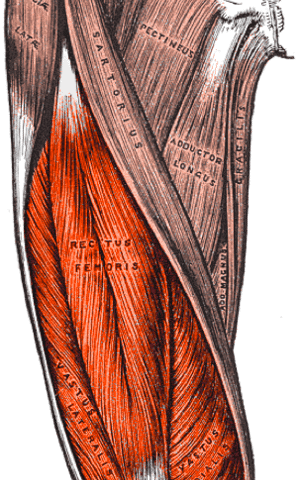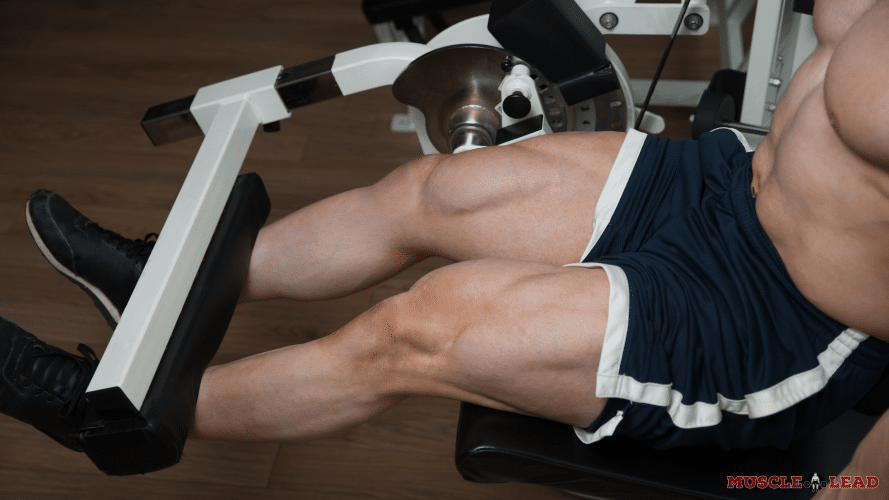Do you know the loads you could rip off the ground with a strong pair of quads? A LOT MORE THAN YOU WOULD IF YOU HAD WEAK ONES! So, let’s see how exactly deadlifts work quads!
Doing the deadlift itself has many strength based benefits for the quads. But you need strong enough quads to do them in the first place.
If your quads are lacking during the deadlift, there are ways to identify and then work on them. This can allow you to deadlift effectively.
For this reason, we have put together an article to discuss:
- “What Are The Quads?”
- “The Role Of Quads In The Deadlift?”
- “3 Benefits Of Working Quads From The Deadlift”
- “4 Indicators That Highlight Weak Quads During The Deadlift?”
- “4 Ways To Strengthen The Quads”
What Are the Quads?
The quads is the formal name given to 4 muscles on the thigh (1). These muscles are broken down into:
- Vastus Lateralis (outer thigh)
- Vastus Medialis (inner thigh)
- Vastus Intermedius (Centre thigh)
- Rectus Femoris (Deep center thigh)
The vastus muscles connect from the upper leg bone into the knee tendon. The rectus femoris starts at the hip bone (1).

For this reason, these muscles come together to extend the knee joint (1). You may be more familiar with the term straightening the lower leg.
The rectus femoris has a special function from its unique attachment. It helps with flexing the hip (1). This is basically driving the hip backwards as if you were going to sit or squat down.
Do Deadlifts Work Quads?
As we have learnt the rectus femoris helps with the sit down motion. Where do we sit down during the deadlift?
CORRECT! We flex at the hips, knees and ankles to get into the starting position. Sitting in this position alone would activate the quads isometrically (no change in muscle length).
As we begin to lift the bar, the quads come in to play the most while extending at the knee joint (2).
This makes perfect sense from our previous section.
These movements would become difficult with weak quads. So, deadlift indeed does work the quads.
Read whether Deadlifts Work Your Traps
3 Benefits of Working Quads from the Deadlift
We concluded that deadlift does work the quads, but what are the benefits actually?
There are 3 main quadricep benefits when deadlifting. You could expect muscle and strength gains. The quadricep movements could also translate into sports. I have discussed these benefits in more detail below.

1. Muscular Hypertrophy
Without a doubt, deadlifting at a reasonable intensity and with good form would activate fast twitch muscle in the quadriceps (2).
Over time, this would grow the cross section of quadricep muscles. So larger and more defined quadricep muscles.
2. Strength Developments
Muscle size and strength go hand in hand. Deadlifting overtime would strengthen the quadricep movement action of knee extension (2). This movement action can translate into other lifts like:
- Barbell Back Squats
- Hack Squats
- Lunges
- Bulgarian Split Squat
- Piston Squat
- Leg press
- Leg extensions
3. Sports Transferability
Athletes and sports participants can also reap some of the benefits of the deadlift quadricep action.
Strong quads and similar movement patterns are used in sports like:
- Jumping
- Sprinting
- Kicking a ball
- Boxing
- Wrestling
Let’s use the jump as an example. Crouching down and jumping uses an identical movement pattern as the deadlift. The quadriceps would pop into action to get off the ground.
4 Indicators That Highlight Weak Quads During Deadlifts
It is easy to figure out if the quads are the weak link in the deadlift. Generally, lifting past a certain point would become difficult. The quads may begin to shake and other areas of the body may take the load.
Why Your Deadlift is Weak Off the Floor (7 Tips)
This also poses a higher injury risk. We have discussed these 4 indicators below.
1. Inability to Get the Bar Past the Knees
In fact, this is the biggest indicator. It only makes sense that a lifter would not be able to extend at the knee joint. From here, it is highly unlikely that the bar would pass the knee caps.
It is very common for lifters to get stuck at the shin position. At times they begin to jerk the bar, or compensate with other areas of the body.
2. Legs Shaking
The legs shake when they are not particularly strong enough for the lift. This is because more muscle fibers have to step in. If you have strong quads, the moment should be smoother.
3. Other Muscles Compensating
When the quads are not strong enough to fulfill their purpose, other muscles may come into play.
For example the back may start curving and/or the hip joint may take more of the tension. This would bring the glute muscles to take more of the action.
4. Skeletal Injury
It is possible to injure the quadricep directly if they are weak. Other areas could also get injured. If the back curves to compensate for weak quads, you could experience a spinal Injury.
We always try to hammer the importance of maintaining a neutral spine in any lift. The injury risk is real and could put you out of action for a while.
Furthermore, if a lifter jerks the bar to get it up, there is a risk of muscle strain. For example, the biceps could be at higher risk of tearing from rapid hyper extending.
4 Ways to Strengthen The Quads
Not all is lost If you can relate to any of the 4 indicators mentioned. You can strengthen the quads with high intensity isolation, strengthening specific deadlift positions, and deadlifting more. We have gone over 4 expert tips below.
1. Isolate the Quads More Frequently
Some lifters are totally against training a muscle group more than once per week. I too did not like the idea in the first few years of working out.
There seems to be an irrational fear of overtraining. I think it stems from gym bros taking research out of content and just chaining on false information.
Truth be told, there is nothing wrong with working a muscle group more than once per week, especially if it is genetically not your strong point.
Training the quads more frequently will give them additional stimulus and lengthen muscle protein synthesis (muscle building). In turn, this can make them bigger and stronger in the longer term.
It entirely depends on the person, but we could be looking at 2-6 extra quad exercises per work per week i.e., leg extensions.
Once you have stronger quads, it could help bust through the sticking point off the floor.
2. Isolate the Quads at Higher Intensities
Based on what we know about strength training, a muscle group has more potential to get stronger when you go hard and heavy. Of course, this will vary from person to person.
So a lifter could train within 80-100% of their 1RM giving them 1-5 reps per exercise set.
For example, let’s say that a lifter with 80% leg extension sits at ~220 lbs. This may put you in the ballpark of 5-6 reps before t tiring out.
3. Incorporate Isometric Deadlift
We all know that during the deadlift we can face sticking points. What does this mean? So basically a range of the deadlift that you can not pull past.
This can be where the bar is; ankle height, knee height, hip height, or even higher. As we mentioned my sticking point was above knee position.
So an isometric deadlift is essentially an exercise that focuses on a specific deadlift position.
Ultimate Guide to Isometric Deadlift: 7 Benefits and How to
To be specific, pulling a bar against the squat rack safety pin. When done properly, this should draw the muscles and movement pattern of your sticking point.
In fact, it is the ultimate contraction without changing the length of a muscle.
Slotting the pins at the mid shin point will allow you to draw the muscles of the quads. Over time, this can help grow the quads bigger and stronger.
4. Deadlift More Frequently
I am a firm believer that to make a lift stronger, we must focus on that lift itself. We could do all the leg extension we want, but to get the full movement pattern going. We must use the deadlift.
This is not to say that you would neglect the other mentioned methods. Ideally, you or a qualified professional could put together a program that focuses on the quad strength, if needed.
Learn High Rep Deadlifts: 4 Amazing Benefits (Science-Backed)
Final Thoughts
We have learnt that the quads are 4 smaller muscles of the thigh. These muscles straighten the leg at the knee joint. The rectus femoris also helps get into a seated position.
During the deadlift the knees extend to lift the bar past the shin position. So deadlifts work the quads! Go out there and get to lifting.
Frequently Asked Questions
Absolutely! The deadlift is considered a quad exercise the upper body too.
This is called DOMs from breaking down muscle fibers, in my experience the worst on the 3rd day.
Rest and eat more protein (if needed) for growth and repair.
References
- Spiliopoulou, P., Methenitis, S., Zaras, N., et al. “Vastus Lateralis and Vastus Intermedius as Predictors of Quadriceps Femoris Muscle Hypertrophy after Strength Training” Applied Science. 2022;12 (18): 9133
- Diamant, W., Geigster, S., Havers, T., et al. ‘Comparison of EMG Activity between Single-Leg Deadlift and Conventional Bilateral Deadlift in Trained Amateur Athletes – An Empirical Analysis’ International Journal Of Exercise Science. 2021; 14(1): 187–201





